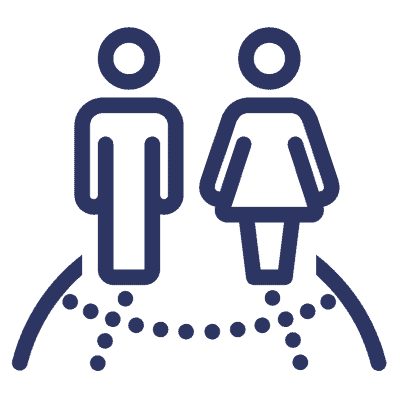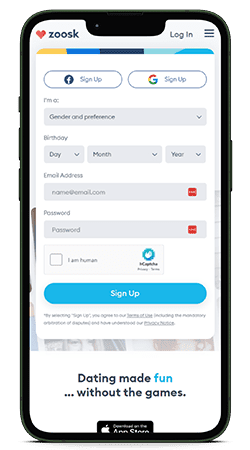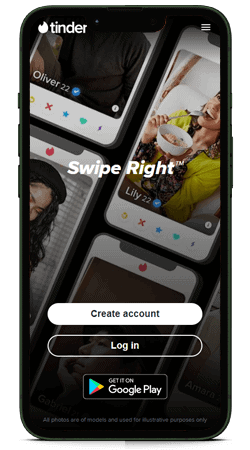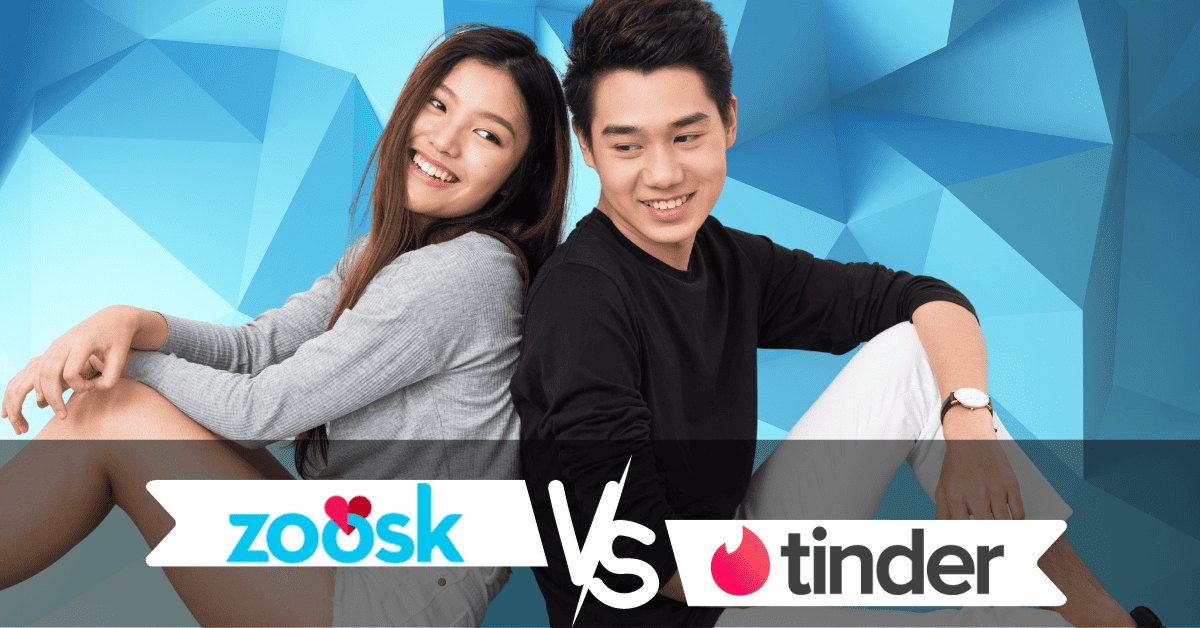Among the giants of online dating, two namesare battling it out in the crowded field: Zoosk vs Tinder. Zoosk, founded in 2007, has always been about closing the gap between social networking and online dating, doing so with a behavioral matchmaking system. By clocking users’ interactions and preferences on the app, it offers a much more tailored dating experience, with its goal to recommend matches that will most likely be more compatible with each user.
On the other hand, Tinder, which broke out in 2012, truly revolutionized the dating scene with its simple and intuitive swiping function. “Swipe right” has taken on a life outside the dating app, making it a cultural phenomenon. As an app that promotes snap decisions based on nothing but first impressions, it caters to a younger audience seeking a more casual dating experience.
Both apps undoubtedly have their distinct appeal, but they cater to slightly different demographics and romantic intentions.
Zoosk’s sophisticated algorithm and a more profile-centric approach might appeal to those seeking real connections, emphasizing compatibility based on shared interests and behaviors. It’s an environment where users might spend more time crafting their profiles and engaging in thoughtful chats. Tinder, with its iconic ‘swipe left or right’ tool, is designed for swift interactions. Its ethos is more about volume and spontaneity, where potential connections are made or gone in a split second. This will no doubt appeal to those who like to live in the moment.
When all is said and done, your choice between Zoosk and Tinder will depend on what you want to get out of online dating. Are you looking for a platform that curates potential matches based on real compatibility? Or are you after the excitement of rapid match-making and the spontaneity it brings? Both platforms have their high points and can offer great connections, but the route to get to those will differ.
We’re gonna do a comprehensive comparison detailing the differences and similarities of each platform—welcome to the online octagon of Zoosk vs Tinder!
Key Differences at a Glance
Choosing between platforms as prominent as Zoosk and Tinder can be confusing—each app offers its unique set of features and approaches to help you find your match. Let’s take a gander at the basic stats of each one.
| Zoosk | Tinder | |
|---|---|---|
Demographics | Tends to attract a more mature audience, including individuals looking for serious relationships. | Popular among a younger crowd, often those seeking more casual relationships or experiences. |
Matchmaking Algorithm | Uses a behavioral matchmaking system to provide tailored suggestions based on user interactions and preferences. | Primarily location-based, users swipe right (like) or left (dislike) based on first impressions. Matches occur when both users swipe right. |
Features | Carousel feature for rapid profile viewing, SmartPick introductions based on compatibility, and the ability to search for profiles based on specific criteria. | The swipe mechanism is central; also offers Boost (increasing profile visibility), Super Like (showing heightened interest), and Tinder Passport (changing location). |
Usability | Offers both a website and a mobile application with a user-friendly interface. | Primarily app-based, known for its simple and quick interface. |
Premium Services | Premium memberships offer features like seeing who viewed your profile, chat features, and full access to SmartPicks. | Tinder Plus and Tinder Gold offer features like unlimited likes, rewinds on swipes, and seeing who liked you before you decide. |
Both platforms cater to different preferences and intentions. While there’s some overlap, Zoosk tends to be more comprehensive and tailored, whereas Tinder emphasizes speed and initial attraction.
User Demographics

Understanding user demographics can provide valuable insight into the typical audience of a platform and aid in determining which might be the best fit for individual needs. Here’s a breakdown of the user demographics for Zoosk and Tinder:
- Zoosk:
- Age Range: While Zoosk caters to a wide range of age groups, it tends to be popular among users in their late 20s to early 40s.
- Relationship Intent: Users often lean towards seeking serious relationships or long-term commitments.
- Geographic Spread: With a presence in over 80 countries, it attracts an international user base. It’s also available in 25 languages, catering to a diverse group.
- User Base: Zoosk boasts over 40 million members, with a relatively even gender distribution.
- Tinder:
- Age Range: Predominantly popular among the younger crowd, especially those aged 18-35.
- Relationship Intent: While there are certainly users seeking serious relationships, Tinder has a reputation for being geared more toward casual dating and hookups.
- Geographic Spread: Tinder’s reach is global, being available in 190+ countries. Urban areas, in particular, see a high concentration of Tinder users.
- User Base: As one of the most popular dating apps, Tinder has amassed over 50 million users globally, with millions of daily active users.
The contrasting demographics between Zoosk and Tinder highlight online daters’ diverse needs and preferences. While Zoosk appeals more to those seeking committee partnerships, Tinder resonates with a younger audience who like spontaneity and quick and casual connections.
User Interface and Experience

The user interface (UI) and overall user experience (UX) play critical roles in the success and appeal of dating platforms. Here’s how Zoosk and Tinder fare in terms of UI and UX:
- Zoosk:
- Design: Zoosk offers a clean, intuitive interface. The platform is designed with straightforward navigation in mind, incorporating both grid and list views for profile browsing.
- Features Accessibility: Features like the Carousel (for quick profile viewing) and SmartPick (tailored match suggestions) are easily accessible from the main dashboard.
- Interactivity: Zoosk offers various ways to show interest, such as sending smiles, hearts, or messages. It’s built to facilitate deeper interaction.
- Mobile and Web: Both the website and mobile app versions are well-optimized and consistent in terms of design and functionality.
- Feedback & Support: Zoosk provides prompts and notifications to guide users. The help section and customer support are relatively easy to access.
- Tinder:
- Design: Tinder’s design is sleek and minimalist, built around the card-swiping mechanic. The interface is visually engaging, focusing on user photos with brief profile information.
- Features Accessibility: Core features like swiping, messaging, and profile settings are front and center. Premium features like Super Like and Boost are prominently displayed.
- Interactivity: Tinder’s main interaction is the swipe – right for like, left for nope. The simplicity of this mechanism is a defining feature of the app’s UX.
- Mobile-Centric: While Tinder does have a web version, its primary experience is crafted for mobile, making swiping easy and addictive on the go.
- Feedback & Support: Tinder offers real-time notifications and feedback focusing on immediacy. The support section, though, might require a bit of navigation.
In essence, while Zoosk leans towards a comprehensive dating platform experience with varied features for interaction, Tinder emphasizes a fast-paced, visually-centered experience built around its iconic swiping mechanism.
Features

Features are the backbone of any dating platform, determining how users interact, match, and communicate. Here’s a comparison of the features you can expect if you sign up for Zoosk and Tinder.
- Zoosk:
- Behavioral Matchmaking: Zoosk continually learns from user interactions and preferences to provide better match suggestions over time.
- Carousel: A rapid-fire mode where users can view profiles quickly and indicate interest with a yes or no, similar to the swipe mechanism but with a slightly different presentation.
- SmartPick: Introduces users to profiles based on compatibility. It’s based on the Behavioral Matchmaking system’s insights.
- Search Filters: Allows users to search for potential matches based on specific criteria such as body type, religion, height, etc.
- Virtual Gifts: Users can send virtual gifts, a feature that adds a cute element to any interaction.
- Photo Verification: This feature lets users submit videos to the platform to verify their photos are accurate, increasing trust among members.
- Tinder:
- Swipe Mechanism: The core feature of Tinder. Users swipe right to “like” someone and left to “pass.” Mutual right swipes result in a “match.”
- Super Like: A way to stand out and show more interest in a profile—FYI, it’s limited to use unless you’re a premium user.
- Boost: Increases the visibility of a user’s profile for a limited time, ensuring more potential matches.
- Tinder Passport: Available for premium users, it allows them to change their location and match with people from other cities or even countries.
- Top Picks: Curated selection of profiles for the user to swipe on, based on Tinder’s algorithm.
- Tinder U: A feature designed for college students to connect with peers on their campus or neighboring schools.
While both platforms offer a whole host of fun features to facilitate connections, Zoosk focuses more on algorithmic suggestions and varied modes of interaction. Tinder, on the other hand, emphasizes the gamified aspect of dating with its swipe mechanism and features that boost profile visibility.
Pricing

Stating platform pricing structures often vary, with different tiers offering enhanced features or benefits. Let’s compare the pricing for Zoosk and Tinder!
- Zoosk:
- Free Membership: Allows profile creation, basic search, and sending “smiles” or hearts. However, communication is limited.
- Premium Membership: 3-month subscription: $59.99 (or $19.98/month) – 6-month subscription: $79.99 (or $13.35/month) – 12-month subscription: $119.95 (or $10.00/month)
- Benefits: Unlimited messaging, full access to SmartPicks, see who viewed your profile, and chat feature. There are also additional coin purchases for features like boosting profile visibility.
- Tinder:
- Free Membership: Allows profile creation, basic swiping with a limited number of right swipes per day, and messaging with matched profiles.
- Tinder Plus: Pricing ranges from $4.50 to $13.49 per month, and discounts are available for longer commitments.
- Benefits of Tinder Plus: Unlimited likes, rewinds on swipes, 5 Super Likes a day, 1 free Boost per month, and a Passport feature to swipe anywhere in the world.
- Tinder Gold (An enhanced premium tier): Pricing is above Tinder Plus, ranging from $7.50 to $22.49 monthly, with discounts for longer term commitments.
- Benefits of Tinder Gold: All features of Tinder Plus, plus the ability to see who liked you before you swipe and access to curated Top Picks.

Background and History: Zoosk vs Tinder
For a bit of context, especially when pondering the giants like Zoosk and Tinder, knowing their origin stories can offer a peek into their current dynamics and appeal. So, let’s rewind the clock and look at the histories of these two influential platforms.

Zoosk
- Established: 2007
- Genesis: Started as a Facebook app initially, Zoosk evolved into a standalone dating platform. Its early integration with social media set it apart, leveraging the then-new concept of using online ‘social graphs’ to optimize match suggestions.
- Evolution: Over the years, Zoosk honed its Behavioral Matchmaking engine, which refines match suggestions based on user activity and interactions. It’s grown from a simple app to a full-fledged platform with a presence in over 80 countries.

Tinder
- Established: 2012
- Genesis: Emerging from a startup incubator called Hatch Labs, Tinder introduced a new, simplistic way of digital dating. The idea was to emulate the real-life process of judging initial attractions.
- Evolution: Tinder’s “swipe” quickly became iconic. Over time, the app expanded its features, introduced premium tiers, and became a cultural phenomenon, especially among the younger demographic. It emphasized the gamification of dating and instant gratification.
As we compare Zoosk and Tinder, it’s clear that while both serve the purpose of connecting individuals, their approaches, rooted in their distinct histories, cater to different aspects of the dating spectrum.
Free Trial Comparisons: Zoosk vs Tinder
Zoosk and Tinder offer free trials and have pretty decent freemium versions, meaning you can try before you buy—or not buy at all! Let’s check out what you get for free on both apps.

Zoosk Free Trial
- Basic Free Access: Zoosk provides a free version, allowing you to create a profile, execute searches, and extend winks to fellow users, although messaging capabilities are confined.
- Occasional Special Trials: Every now and then, Zoosk offers free trials or promotions, granting temporary access to select premium features for a specified duration—check their website or app to find out if there are any offers!

Tinder Free Trial
- Free Version: You can swipe, match, and chat with other free users when you both like each other.
- Daily Likes: You can only like a certain number of people each day.
- Geographic Limits: You can only swipe on people who are nearby.
Success Rates: Zoosk vs Tinder
Success rates for dating apps can be somewhat nebulous and challenging to quantify definitively because “success” can mean different things to different users. Some might define success as finding a long-term partner, while others view it as having enjoyable dates or expanding their social circle. Here’s what we know!

Zoosk
- Claims: Zoosk boasts that its behavioral matchmaking engine makes more meaningful matches, leading to more positive dating experiences.
- Numbers: Exact success rates in terms of long-term relationships or marriages resulting from Zoosk matches aren’t widely published. However, with over 40 million members worldwide, many users have found meaningful connections.
- Testimonials: The platform features several success stories and testimonials on its website, with couples sharing their positive experiences and relationships that stemmed from Zoosk.

Tinder
- Claims: Tinder’s emphasis traditionally has been on creating quick matches and facilitating connections rather than specifically targeting long-term relationships.
- Numbers: As of my last update, Tinder claims to facilitate over 1 million dates per week. Given its vast user base and the sheer volume of interactions, many users have found relationships, both short-term and long-term, through Tinder.
- Testimonials: Anecdotal evidence, like stories shared on social media or other platforms, suggests that numerous people have found meaningful relationships on Tinder. Some have even tied the knot.
It’s worth noting that individual experiences can vary widely based on factors like location, age, intent, and how one uses the app. Moreover, neither platform can guarantee success, as a lot depends on personal interactions, chemistry, and timing. However, the sheer volume of users and matches on both platforms indicates that many have found dating success using them!
Signing Up: Zoosk vs Tinder
Sign-up is the first step in joining a dating platform and can shape a user’s initial impression. Here’s how the process works for both Zoosk and Tinder!

Zoosk
- Method: Users can sign up using an email address or connecting their Facebook or Google accounts.
- Steps:
- Provide basic information, including gender, birthday, and location.
- Create a username and password.
- Upload a profile picture (with an option for photo verification).
- Fill out a brief profile with personal details, including body type, children, education, and smoking/drinking habits. This is optional but helps in refining matches.
- The platform may prompt users to answer additional questions to improve match accuracy.
- Email Verification: If signing up with an email, Zoosk requires users to verify their address by clicking on a link sent to them.

Tinder
- Method: Tinder primarily uses phone numbers for sign-up, but users can also register using their Facebook account.
- Steps:
- Enter your phone number or connect your Facebook account.
- If using a phone number, verify it by entering a code sent via SMS.
- Set up a profile by adding photos, writing a bio, and selecting preferences (gender, interest, age range, distance).
- Tinder will automatically pull location data (but users can adjust their location settings).
- The app may prompt users to connect to other accounts, such as Instagram or Spotify, to enhance their profile.
Both platforms aim to make the sign-up process as streamlined as possible, allowing users to start browsing and connecting quickly. While Tinder emphasizes rapid profile setup and getting started with swiping, Zoosk offers a slightly more detailed initial setup, which can contribute to more compatible matchmaking.
Dedicated Mobile Apps: Zoosk vs Tinder
Both Zoosk and Tinder have dedicated mobile apps that cater to users who want to find dates or love while on the go. Here’s a breakdown of the mobile experience each platform offers:

Zoosk
- Availability: Available for both iOS and Android devices.
- Design: The Zoosk app mirrors the website’s functionality, presenting a clean and intuitive interface. Icons and options are clearly labeled, making navigation straightforward.
- Features: Users can access the Carousel, view and send messages, see SmartPicks, and purchase and use Zoosk coins. The app also allows for photo uploads directly from the phone.
- Notifications: The app provides real-time notifications for messages, views, and other interactions, ensuring users stay updated.
- Performance: Generally smooth, though some users have reported occasional glitches or delays in notifications.

Tinder
- Availability: Available for iOS and Android.
- Design: With a sleek and modern design, the app emphasizes visuals, primarily focusing on profile pictures. Its minimalist interface prioritizes the swiping mechanism.
- Features: Core features like swiping, messaging, and profile editing are front and center. Premium features like Super Like, Boost, and Passport are also easily accessible.
- Notifications: Tinder’s app is optimized for real-time notifications, alerting users immediately when they have a match or receive a message.
- Performance: Renowned for its fast-paced swiping experience, the app generally offers smooth performance. However, as with any app, occasional issues can arise.
Both apps cater to their respective user bases effectively. Zoosk’s app brings its web experience to mobile, emphasizing the platform’s matchmaking tools and features. In contrast, Tinder’s mobile app stays true to its brand, focusing on quick, visually-driven interactions and the simplicity of the swipe mechanism.

What’s Zoosk Best For?
Zoosk is a versatile dating platform that appeals to a broad range of users. However, it has certain standout features and qualities that cater to specific dating needs and scenarios. Here’s what Zoosk is particularly good at:
- Diverse User Base: With over 40 million members from various backgrounds and demographics, Zoosk boasts a diverse user pool, increasing the chances of finding a compatible match.
- Behavioral Matchmaking: Zoosk’s unique algorithm learns from users’ actions and preferences to provide tailored match suggestions. This benefits those who prefer a more personalized dating experience without filling out extensive questionnaires.
- Flexible Dating Goals: Whether users are looking for casual dates, serious relationships, or just new friendships, Zoosk’s versatile platform accommodates various intentions.
- Photo Verification: Zoosk offers a photo verification feature for those concerned about authenticity. This helps ensure that members’ pictures match their real-life appearance, fostering trust among users.
- Safety Features: With features like the panic button, anti-harassment measures, and the ability to easily report or block abusive members, Zoosk emphasizes user safety.
- Ease of Use: For individuals new to online dating or those who want a straightforward experience without complex features, Zoosk’s intuitive interface is a plus.
- International Reach: Zoosk is available in over 80 countries and translated into 25 languages for those open to connecting with people from different countries.
Zoosk is best for individuals seeking a versatile dating platform that combines algorithm-based matchmaking with user-driven preferences. It’s particularly suitable for those who value a mix of serious and casual connections, safety features, and an authentic, diverse user base.

What’s Tinder Best For?
Since its inception, Tinder has garnered immense popularity and reshaped the dating app landscape with its iconic swipe mechanism. Here’s what Tinder is mainly known for and excels at:
- Quick Matches: Tinder’s swipe-left or swipe-right mechanism allows users to quickly go through profiles and make instant decisions, making it suitable for those who enjoy a fast-paced dating experience.
- Casual Dating and Hookups: While many have found long-term relationships on Tinder, its reputation leans more towards casual dates and hookups, given its quick matching system.
- Younger Demographic: Tinder tends to attract a younger user base, primarily in the 18-35 age range. It’s popular among college students and young adults looking for a fun, spontaneous dating experience.
- Global Presence: With its vast user base, Tinder is used worldwide. The Passport feature, available for premium users, even allows members to match with people from other cities or countries.
- Simplicity: The app’s minimalist design and straightforward functionality make it easy for anyone, tech-savvy or not, to get started and engage.
- Social Media Integration: Users can connect their Spotify and Instagram accounts, allowing for deeper insights into potential matches beyond just profile pictures and bios.
- Short-Term Connections: Given its quick match mechanism, Tinder is ideal for those who are traveling or relocating and want to meet new people quickly.
- Events and Group Features: With features like “Tinder U” for college students and “Festival Mode” for music festival goers, Tinder often introduces new ways for like-minded individuals to connect based on events or shared experiences.
Tinder is best for those looking for a fast, fun, and casual dating experience. It’s particularly favored by younger users, travelers, and those looking to meet new people without having to craft super-detailed profiles or extensive questionnaires.
Takeaways
Zoosk and Tinder, both giants in the online dating realm, cater to different target demos of the dating population. While Zoosk offers a personalized, versatile platform suitable for those seeking a mix of serious and casual relationships, Tinder is the go-to for a fast-paced, spontaneous experience, often favored by younger users and those leaning towards casual connections.
Your choice between the two will depend on personal preferences, dating goals, and the kind of user experience you’re after. Regardless of the platform, always approach online dating with an open mind, and remember, safety first!




